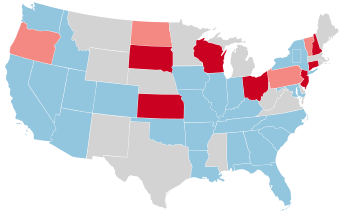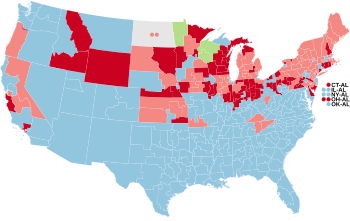
The 1938 United States Senate elections occurred in the middle of Franklin D. Roosevelt's second term. The 32 seats of Class 3 were contested in regular elections, and special elections were held to fill vacancies. The Republicans gained eight seats from the Democrats, though this occurred after multiple Democratic gains since the 1932 election, leading to the Democrats retaining a commanding lead over the Republicans with more than two-thirds of the legislative chamber.

The 1938 United States House of Representatives elections was an election for the United States House of Representatives were elections for the United States House of Representatives to elect members to serve in the 76th United States Congress. They were held for the most part on November 8, 1938, while Maine held theirs on September 12. They occurred in the middle of President Franklin D. Roosevelt's second term. Roosevelt's Democratic Party lost a net of 72 seats to the Republican Party, who also picked up seats from minor Progressive and Farmer–Labor Parties.

The 74th United States Congress was a meeting of the legislative branch of the United States federal government, composed of the United States Senate and the United States House of Representatives. It met in Washington, D.C., from January 3, 1935, to January 3, 1937, during the third and fourth years of Franklin D. Roosevelt's presidency. The apportionment of seats in the House of Representatives was based on the 1930 United States census.
The conservative coalition, founded in 1937, was an unofficial alliance of members of the United States Congress which brought together the conservative wings of the Republican and Democratic parties to oppose President Franklin Delano Roosevelt's New Deal. In addition to Roosevelt, the conservative coalition dominated Congress for four presidencies, blocking legislation proposed by Roosevelt and his successors. By 1937, the conservatives were the largest faction in the Republican Party which had opposed the New Deal in some form since 1933. Despite Roosevelt being a Democrat himself, his party did not universally support the New Deal agenda in Congress. Democrats who opposed Roosevelt's policies tended to hold conservative views, and allied with conservative Republicans. These Democrats were mostly located in the South. According to James T. Patterson: "By and large the congressional conservatives agreed in opposing the spread of federal power and bureaucracy, in denouncing deficit spending, in criticizing industrial labor unions, and in excoriating most welfare programs. They sought to 'conserve' an America which they believed to have existed before 1933."

The 1996 United States elections were held on November 5. Democratic President Bill Clinton won re-election, while the Republicans maintained their majorities in both houses of the United States Congress.

The 1944 United States elections was held on November 7, 1944, during the final stages of World War II. President Franklin D. Roosevelt was easily re-elected to an unprecedented fourth term, and the Democratic Party retained their majorities in both chambers of Congress.

The 1956 United States elections was held on Tuesday, November 6, 1956. Incumbent Republican President Dwight D. Eisenhower won reelection in a landslide, while the Democrats retained control of Congress.

The 1950 United States elections were held on November 7, 1950, and elected the members of the 82nd United States Congress. The election took place during the Korean War, during Democratic President Harry S. Truman's second term. The Democrats lost twenty-eight seats to the Republican Party in the House of Representatives. The Democrats also lost five seats in the U.S. Senate to the Republicans. The defeat of the Labor Party congressman Vito Marcantonio left third parties without representation in Congress for the first time since 1908.

The 1946 United States elections were held on November 5, 1946, and elected the members of the 80th United States Congress. In the first election after World War II, incumbent President Harry S. Truman and the Democratic Party suffered large losses. After having been in the minority of both chambers of Congress since 1932, Republicans took control of both the House and the Senate.
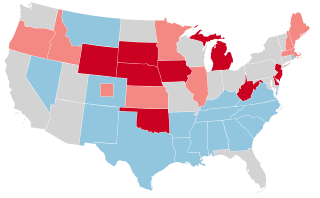
The 1942 United States elections were held on November 3, 1942, and elected the members of the 78th United States Congress. In Democratic President Franklin D. Roosevelt's unprecedented third mid-term election and during World War II, the Republican Party picked up seats in both chambers. Still, the Democrats retained control of Congress.
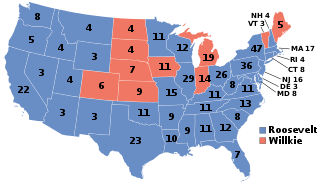
The 1940 United States elections was held on November 5. The Democratic Party continued to dominate national politics, as it defended its Congressional majorities and retained the presidency. It was the last election prior to the attack on Pearl Harbor and America's entry into World War II.

The 1936 United States elections were held on November 3, 1936, during the Great Depression. Democratic President Franklin D. Roosevelt trounced Governor Alf Landon of Kansas in a landslide and the Democrats built on their majorities in both chambers of Congress.
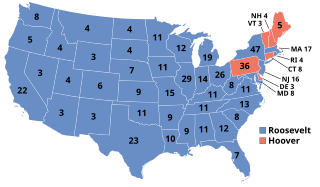
The 1932 United States elections were held on November 8, during the Great Depression. The presidential election coincided with U.S. Senate, U.S. House, and gubernatorial elections in several states. The election marked the end of the Fourth Party System and the start of the Fifth Party System. The election is widely considered to be a realigning election, and the newly established Democratic New Deal coalition experienced much more success than their predecessors had in the Fourth Party System.

The 1930 United States elections were held on November 4, 1930, in the middle of Republican President Herbert Hoover's term. Taking place shortly after the start of the Great Depression, the Republican Party suffered substantial losses. The election was the last of the Fourth Party System, and marked the first time since 1918 that Democrats controlled either chamber of Congress.
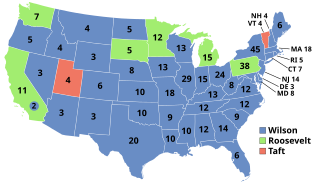
The 1912 United States elections elected the members of the 63rd United States Congress, occurring during the Fourth Party System. Amidst a division between incumbent Republican President William Howard Taft and former Republican President Theodore Roosevelt, the Democratic Party won the Presidency and both chambers of Congress, the first time they accomplished that feat since the 1892 elections.

The 1904 United States elections elected the members of the 59th United States Congress. It occurred during the Fourth Party System. Republicans maintained control of the Presidency and both houses of Congress. For the first time since the 1828 election, no third party or independent won a seat in Congress.

The 1900 United States elections elected the 57th United States Congress. The election was held during the Fourth Party System. Republicans retained control of the Presidency and both houses of Congress, while third parties suffered defeats.
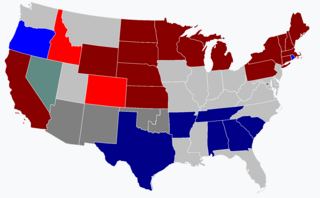
The 1902 United States elections elected the 58th United States Congress, and occurred in the middle of Republican President Theodore Roosevelt's first term, during the Fourth Party System. Roosevelt had become president on September 14, 1901, upon the assassination of his predecessor, William McKinley. Republicans retained a majority in both chambers of Congress, while the Populist Party and Silver Republican Party disappeared from Congress.

The 1856 United States elections elected the members of the 35th United States Congress and the President to serve from 1857 until 1861. The elections took place during a major national debate over slavery, with the issue of "Bleeding Kansas" taking center stage. Along with the 1854 elections, these elections occurred during the transitional period immediately preceding the Third Party System. Old party lines were broken; new party alignments along sectional lines were in the process of formation. The Republican Party absorbed the Northern anti-slavery representatives who had been elected in 1854 under the "Opposition Party" ticket as the second-most powerful party in Congress. Minnesota and Oregon joined the union before the next election, and elected their respective Congressional delegations to the 35th Congress.

The 1858 United States elections occurred in the middle of Democratic President James Buchanan's term and marked the end of the transitional period between the Second Party System and the Third Party System. Members of the 36th United States Congress were chosen in this election. In the first election since the Supreme Court decided Dred Scott v. Sandford, the Republican Party won a plurality in the House, taking control of a chamber of Congress for the first time in the party's history. Although Democrats lost control of the House, they retained their majority in the Senate.
